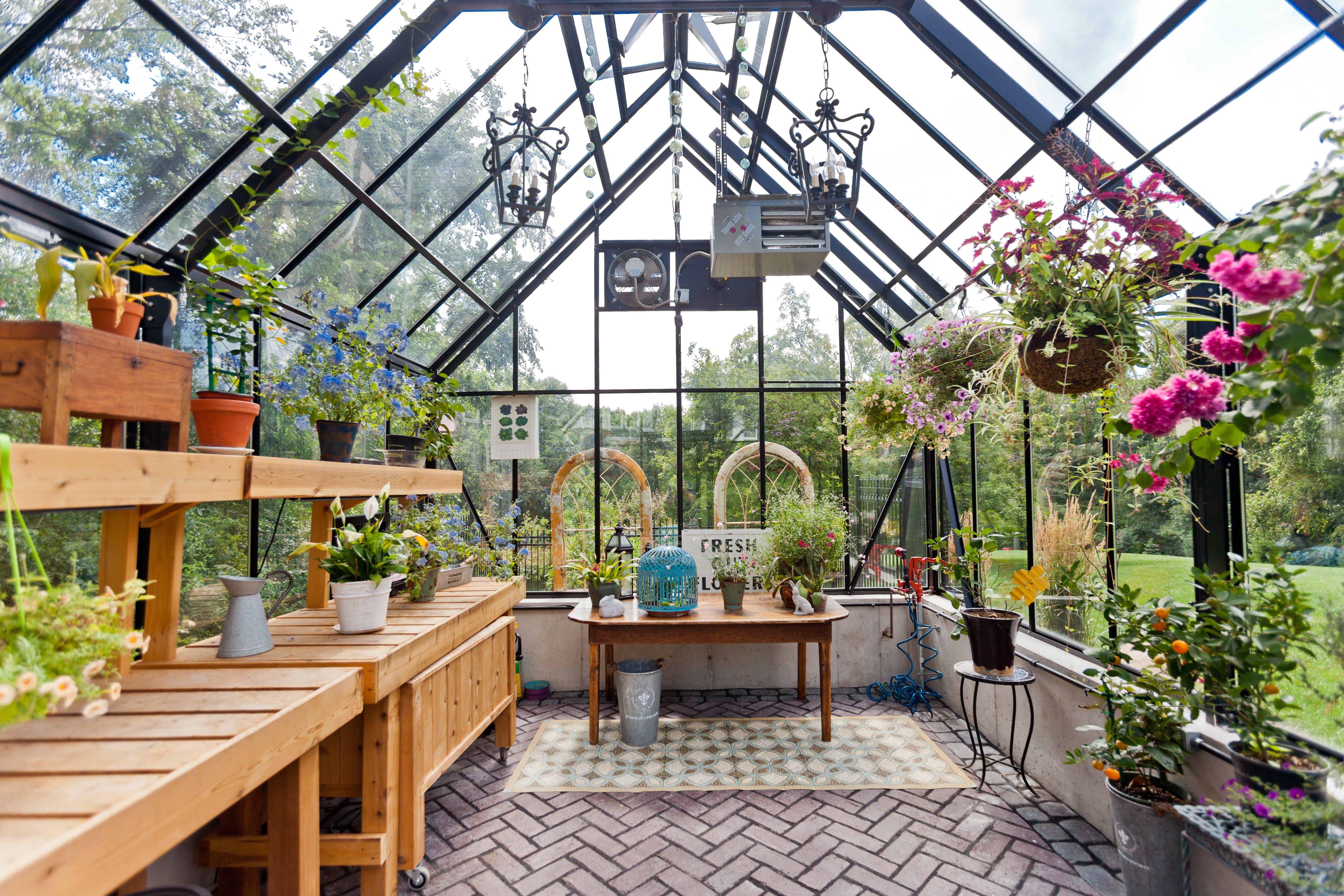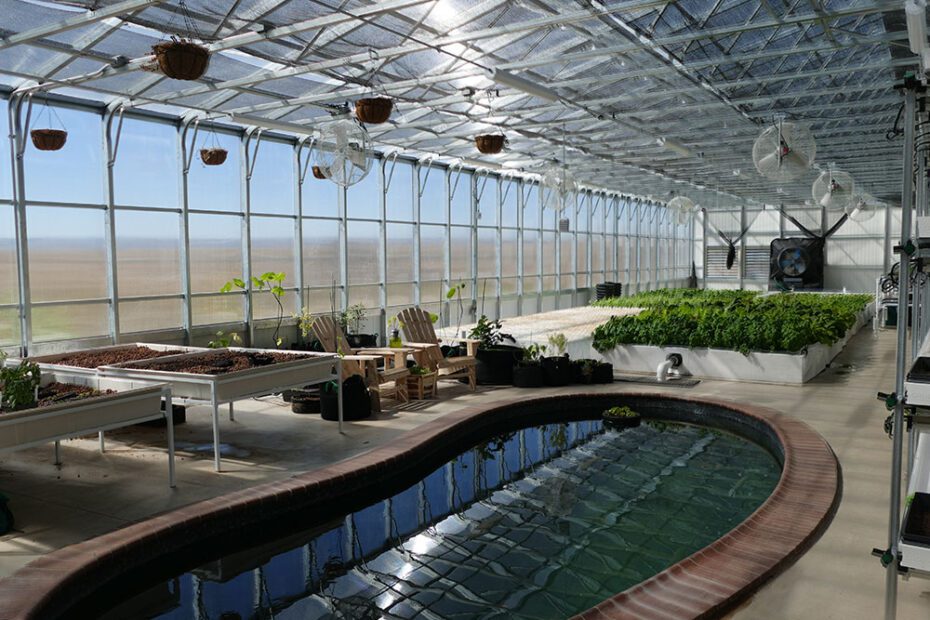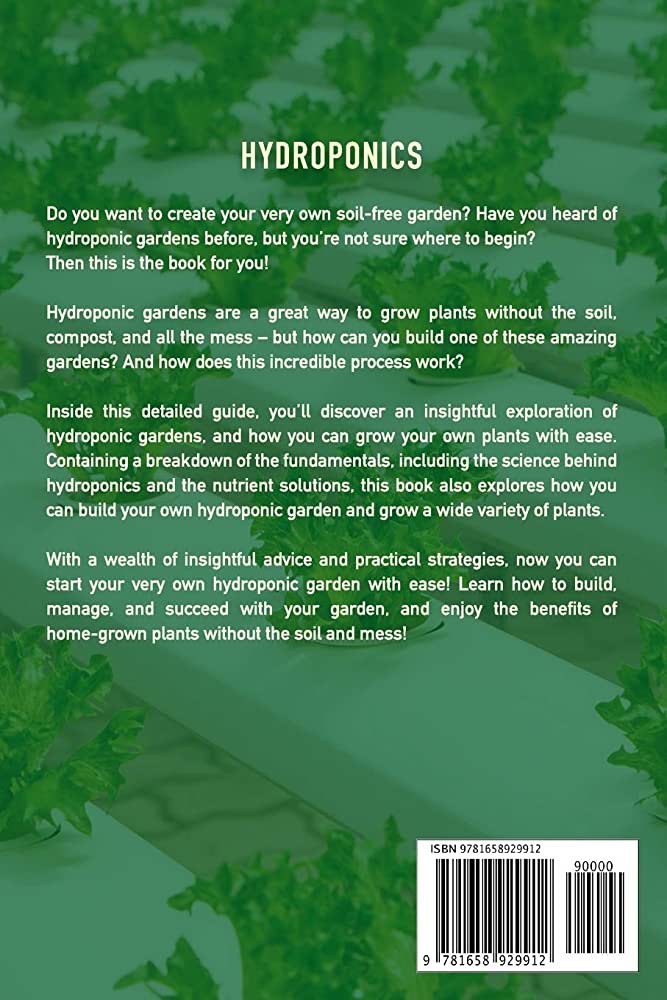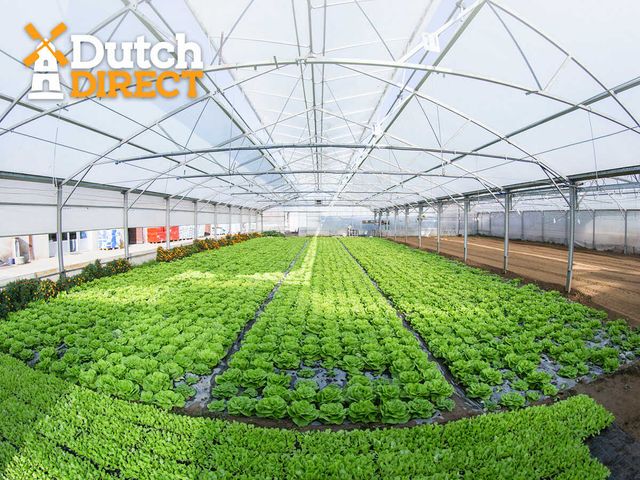Aquaponic greenhouse design is a system that combines raising fish with growing plants. It is a self-sustaining and scalable method of food production.
Aquaponic greenhouses are becoming increasingly popular as a sustainable and efficient method for growing fruits, vegetables, and fish. The system is designed to work symbiotically, with the fish providing the nutrients needed for plant growth, while the plants filter the water for the fish.
In this article, we will provide an overview of aquaponic greenhouse design, covering topics such as system components, layout, and maintenance. We’ll also discuss the benefits of using an aquaponic greenhouse, including reduced water use, increased crop yields, and year-round production. Whether you’re a small-scale hobbyist or a commercial grower, an aquaponic greenhouse can help you produce fresh, healthy food while minimizing your environmental footprint.

Credit: blog.bcgreenhouses.com
Understanding Aquaponic Greenhouse Design
Explanation Of Basic Concepts And Principles Of Aquaponic Greenhouse Design
Aquaponic greenhouse design refers to the process of creating a sustainable, closed-loop system that combines aquaculture (fish farming) and hydroponics (soil-less plant cultivation). Here are some concepts and principles of aquaponic greenhouse design:
- Fish waste provides nutrients for the plants, while the plants purify the water for the fish to live in.
- The cycle starts as fish produce waste, which is turned into ammonia. The ammonia is then converted into nitrites, which are eventually transformed into nitrates that serve as fertilizer for the plants.
- The pumping cycle ensures that the water is constantly recirculating, bringing vital nutrients and oxygen to both the fish and plants.
- The aquaponic greenhouse design provides organic, fresh and locally grown produce and fish, reducing carbon footprint and addressing food scarcity.
Importance Of Choosing The Right Location, Materials, And Structural Design
Choosing the appropriate location, materials, and structural design of the greenhouse is critical for the success of the aquaponic system. Here are some reasons why:
- Location: A suitable location should have good exposure to sunlight and easy access to water and electricity. It should also be sheltered from strong winds and other extreme weather conditions.
- Materials: The materials used for building the greenhouse should be durable and able to withstand weather variations. For example, using high-quality polycarbonate or uv-stabilized polyethylene for the walls and roof can help reduce heat loss and improve light transmission.
- Structural design: The design of the greenhouse should optimize the airflow and distribution of nutrients and light to the plants. An efficient layout of the fish tanks and grow beds, along with the use of automated systems for ventilation, irrigation and fertilization, can reduce manual labor and increase the yield of the system.
Factors To Consider When Designing An Aquaponic Greenhouse
When designing an aquaponic greenhouse, several factors need to be taken into consideration for the system’s proper functioning. Here are some of them:
- Temperature: Fish and plants have optimal temperature ranges, and maintaining a consistent temperature is important for their growth and survival. Appropriate heaters, fans and insulation systems should be included in the greenhouse design.
- Humidity: The level of humidity in the greenhouse affects plant growth and reduces evaporation from the fish tanks. Natural ventilation, misting systems, and dehumidifiers can help regulate the moisture levels.
- Light: Plants need adequate light to grow and produce fruits and vegetables. Incorporating natural light sources, like skylights or shading cloth, can help reduce energy consumption and ensure optimal light conditions.
- Carbon dioxide: Plants obtain carbon dioxide from the air for photosynthesis, so maintaining high air quality is important. Carbon dioxide generators or adapters can help regulate co2 levels and provide better plant growth.
- Water flow: Water flow distributes nutrients, oxygen, and bacteria throughout the system. Sizing of the piping, pumps and valves to maintain a consistent flow rate is essential.
- Other factors: Maintenance, pest control, aeration system, filtration system, monitoring systems, and ph monitoring are additional important factors to consider.
Planning For Maximizing Growth Potential: Aquaponic Greenhouse Design Overview
How To Plan For Maximum Growth Potential In An Aquaponic Greenhouse:
Aquaponic greenhouse is an innovative way of growing plants and aquatic animals in a closed-loop system. The aquaponic system combines aquaculture and hydroponic techniques to create a sustainable environment that maximizes growth potential. Here are some essential factors to consider when designing an aquaponic greenhouse.
- Choosing the right greenhouse: Before choosing the greenhouse for an aquaponic system, consider its shape, size, and location. The greenhouse must provide enough space for the system’s components, including tanks, grow beds, and plumbing systems. The greenhouse should also have a suitable orientation that allows maximum sunlight exposure. Also, ensure that the greenhouse is well insulated to maintain a consistent temperature.
- Determining the suitable system size: The size of the system depends on the desired output and the available space. When planning an aquaponic system, determine the required space for the fish tanks, grow beds, and plumbing systems. A general rule of thumb is to have one pound of fish per 5-10 gallons of water. Also, consider the number of plants you want to grow and the size of the grow beds needed to accommodate those plants.
- Choosing the right fish and plant species: Choose fish species based on their compatibility with each other in the same water temperature range. Tilapia, catfish, and trout are some of the popular species used in aquaponic systems. As for plants, choose species that are compatible with the fish species and can withstand the environment’s temperature and humidity. Herbs, lettuce, and strawberries are some of the easy-to-grow plant species suitable for aquaponic systems.
Creating A Comprehensive Design Plan:
Designing an aquaponic greenhouse requires careful planning to ensure the system’s success and proper functioning. A comprehensive design plan should include the following aspects.
- Hydroponic components: The design plan should include the hydroponic components such as grow beds, media, and irrigation systems. The grow beds should be of a suitable depth to support plant growth and prevent soil erosion. The irrigation system should ensure a constant flow of water to the grow beds and fish tanks.
- Aquaculture components: Aquaculture components like fish tanks, filters, and aeration systems must be included in the design plan. The fish tank should have a suitable volume to accommodate the fish species and ensure proper filtration. The filters should be able to remove solid waste and maintain a healthy environment for the fish.
- Electrical and plumbing components: The design plan should include the location of electrical outlets, lighting fixtures, and plumbing systems. The plumbing system should be well designed to provide a constant flow of water to the grow beds and fish tanks.
Choosing The Right Plants And Fish For Aquaponic Farming:
Choosing the right fish and plant species is crucial to the success of an aquaponic system. The following points should be considered when choosing fish and plants.
- Fish species: When choosing fish species, consider their temperature tolerance, growth rate, and compatibility with other species. Tilapia, catfish, and trout are common species used in aquaponic systems.
- Plant species: Choose plant species that can survive in an aquatic environment and are compatible with the fish species. Herbs, lettuce, and strawberries are easy-to-grow plant species suitable for aquaponic systems.
Understanding The Relationship Between Plants And Fish In An Aquaponic System:
In an aquaponic system, plants and fish have a symbiotic relationship that is crucial to the system’s success. The fish provide nutrients to the plants through their waste, while the plants filter the water for the fish. This relationship is facilitated by the bacteria present in the system, which converts fish waste into plant nutrients.
It is essential to maintain a proper balance between the number of fish and the number of plants in the system to ensure a stable environment. Keeping an eye on the ph level, temperature, and nutrient levels is necessary to maintain this balance.
Best Practices In Aquaponic Greenhouse Design
Aquaponic Greenhouse Design: An Overview
Aquaponic greenhouse design is becoming increasingly popular amongst farmers and gardeners, especially those who are interested in sustainable and organic farming. The system is a combination of aquaculture – the raising of fish or other aquatic creatures, and hydroponics – the growing of plants in water.
The recycled nutrient-rich water from the fish tank feeds the plants which in turn, purify the water for the fish. This provides an excellent symbiotic relationship, where both the plants and the fish thrive. In this blog post, we will discuss best practices in aquaponic greenhouse design.
Strategies For Optimizing Growth Potential In Aquaponic Greenhouses
In order to optimize the growth potential of your aquaponic greenhouse, the following strategies can be employed:
- Choose the right plants: Certain plants are better suited to growing in an aquaponic system, such as lettuce, basil, and other leafy greens. Avoid plants that require a lot of space or extensive root systems.
- Provide proper lighting: Adequate lighting is essential for plant growth. Consider natural lighting, artificial light, or a combination of both. Consult with an expert to determine the appropriate lighting for your specific plants.
- Maintain proper water temperature: Most fish and plants thrive in water temperatures between 68-78℉. Maintain proper temperature levels to ensure optimal plant growth and fish health.
- Add supplements: In some cases, adding supplements to the water may improve plant growth, such as potassium or iron if the system is lacking in these nutrients. Be careful not to add too much as it can affect the ph balance of the water.
- Prune and harvest regularly: Prune plants regularly to prevent overcrowding and ensure that each plant has adequate access to nutrients. Harvest plants when ready to maximize growth potential.
Creating The Optimal Environment For Plants And Fish
To create the optimal environment for plants and fish, consider the following tips:
- Choose the right fish: Different fish species have different temperature and water quality needs. Some common options for aquaponic systems include tilapia, trout, and catfish.
- Maintain proper water quality: Test water quality regularly to ensure that it is free from harmful chemicals or contaminants. Keep the ph balance optimal, between 6.5 and 7.5.
- Choose the right grow media: The right grow media can enhance plant growth, and improve nutrient uptake. Popular options include gravel, clay pebbles, and coconut coir.
- Manage humidity levels: High humidity levels can cause mold and other issues, so it’s crucial to have proper ventilation and dehumidification in the greenhouse.
Ensuring Proper Nutrient Cycling And Water Quality
To ensure proper nutrient cycling and water quality, consider the following practices:
- Monitor and manage the fish waste: Fish waste provides a natural source of nutrients for the plants. However, excess waste can build up and impact water quality. Regularly remove waste and ensure the water is well-circulated.
- Monitor plant health: Plants are the crucial component of the aquaponic system. Monitor their health, and remove any unhealthy plants that could harm the rest of the crop.
- Monitor water levels: Water level management is crucial in an aquaponic system. Regularly check the levels and do manual top-up to ensure that the water levels remain consistent.
- Incorporate beneficial bacteria: Beneficial bacteria are essential for maintaining a healthy system. Adding compost tea can provide a natural source of beneficial bacteria, which can help break down fish waste and improve nutrient cycling.
Employing these best practices in your aquaponic greenhouse design can enhance plant and fish growth, improve the overall health of the system and increase your crop yield.
Challenges And Solutions In Aquaponic Greenhouse Design
Aquaponic Greenhouse Design: An Overview
Aquaponic greenhouse design is an innovative and sustainable method of growing plants and fish together in a closed-loop system. This aquaponic method brings the best of both aquaculture and hydroponics together, creating a symbiotic relationship between plants and fish. Although it offers numerous benefits, there are some challenges that come with designing and farming in an aquaponic greenhouse.
Here we will discuss the common challenges, their solutions, and provide tips on how to troubleshoot any problems that may arise.
Common Challenges In Aquaponic Greenhouse Design And Farming:
- Controlling water quality: In an aquaponic system, the water must be closely monitored and regulated to maintain the ideal conditions for both the plants and fish. Factors such as ph levels, temperature, and nutrient levels must be checked regularly to avoid potential fish and plant stress or even death.
- Maintaining a balanced ecosystem: The system must be balanced to ensure that both the plants and fish are receiving the appropriate nutrients they need. Unequal fish to plant ratio can affect the overall health and growth of the ecosystem.
- System complexity: Designing and setting up an aquaponic system can be complex, requiring knowledge of plumbing, electricity, and biology. It can be overwhelming for beginners to understand how everything fits together.
Strategies For Overcoming These Challenges And Ensuring Long-Term Success:
- Water testing and treatment: Regular water testing and treatment should be implemented to monitor water quality and keep it at an optimum level for plant and fish growth. This can include using filtration systems, uv sterilizers, and oxygenation pumps.
- Fish to plant ratio: Proper planning of fish to plant ratio is crucial in maintaining a balanced ecosystem. It’s recommended to have one pound of fish per five gallons of water and one square foot of growing area for every pound of fish.
- Knowledge and training: Educating oneself through research, training or workshops, and consulting with experts helps in managing a successful aquaponic system. It’s essential to have a deep understanding of biology and maintaining the system to prevent unnecessary loss of fish and plants.
Tips For Troubleshooting Common Problems In An Aquaponic System:
- Observe and monitor the system: Observe and monitor the system to detect potential problems early on, such as changes in water clarity, plant growth, or fish behaviour. Regular maintenance and monitoring can prevent a minor problem from becoming a significant issue.
- Adjust water quality parameters: If the water quality levels are out of balance, adjust them accordingly, such as adding more or less ph buffer or nutrient solution.
- Seek expert advice: Do not hesitate to consult with experts or seek advice from online support groups if any problems arise. They can help with identifying and solving any issues quickly and efficiently.
Aquaponic greenhouse design is an eco-friendly and sustainable method of growing plants and fish. However, to ensure long-term success in this system, it is essential to understand the challenges that arise and utilise solutions and troubleshooting tips to maintain a balanced ecosystem.
With proper planning, training and monitoring, one can create a thriving aquaponic system that yields both plant and animal produce efficiently.
Frequently Asked Questions On Aquaponic Greenhouse Design: An Overview
What Is An Aquaponic Greenhouse?
An aquaponic greenhouse is a system that combines aquaculture and hydroponics to cultivate fish and plants together.
What Are The Benefits Of An Aquaponic Greenhouse?
An aquaponic greenhouse provides fresh produce and fish, reduces water waste, and eliminates the need for traditional fertilizers.
How Does An Aquaponic Greenhouse Work?
In an aquaponic greenhouse, fish are grown in a tank, and their waste provides nutrients for the plants. In turn, the plants filter the water for the fish.
What Plants Can Grow In An Aquaponic Greenhouse?
Herbs, lettuce, kale, and peppers are commonly grown in aquaponic greenhouses. However, many other vegetables and fruits can be grown.
What Species Of Fish Can Be Raised In An Aquaponic Greenhouse?
Tilapia, trout, and catfish are among the most commonly raised fish in an aquaponic greenhouse. However, other species can be raised depending on location and climate.
How Can I Start My Own Aquaponic Greenhouse?
To start an aquaponic greenhouse, you will need a system design, suitable location, and knowledge of fish and plant care. It is recommended to consult with an expert in the field.
Conclusion
After going through our aquaponic greenhouse design overview, it is clear that this is a remarkable system that can revamp our agricultural practices. The system offers several benefits such as efficient resource utilization, year-round production, and low water usage. Additionally, aquaponic systems can be customized to meet specific needs and objectives, and they can be designed to fit any space available.
With the right approach, it is possible to have a thriving aquaponic system that results in high yields and a more sustainable world. Whether you are a seasoned farmer or a novice, aquaponic greenhouse design offers an excellent opportunity to take your farming practices to the next level.
It’s already proven to be a sustainable, efficient, and cost-effective farming method. Therefore, making use of this technology could contribute to achieving food security while preserving our planet’s natural resources. Overall, the aquaponic greenhouse system is worth considering, and we hope this overview has provided you with valuable insights to get started.
- Why Ease of Use is Crucial in Trucking Dispatch Software - September 22, 2024
- Better Communication With Dispatchers: How Trucking Dispatch Software Can Optimize Operations - September 7, 2024
- Maximizing Efficiency: The Importance of Accurate Location Tracking for Trucking Operations - August 23, 2024



